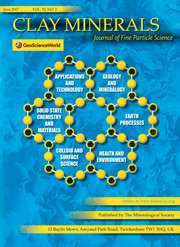Crossref Citations
This article has been cited by the following publications. This list is generated based on data provided by Crossref.
Martin, R. Torrence
1954.
Reference Chlorite Characterization for Chlorite Identification in Soil Clays.
Clays and clay minerals (National Conference on Clays and Clay Minerals),
Vol. 3,
Issue. ,
p.
117.
Scheffer, F.
Meyer, B.
Ulrich, B.
and
Ch. Oloffs, P.
1956.
Zur Frage der quantitativen röntgenographischen Untersuchung von Tonmineralgemischen.
Zeitschrift für Pflanzenernährung, Düngung, Bodenkunde,
Vol. 74,
Issue. 3,
p.
243.
MacEwan, Douglas M. C.
1956.
Fourier transform methods for studying scattering from lamellar systems.
Kolloid-Zeitschrift,
Vol. 149,
Issue. 2-3,
p.
96.
MITCHELL, W. A.
and
IRMAK, A.
1957.
TURKISH FOREST SOILS.
Journal of Soil Science,
Vol. 8,
Issue. 2,
p.
184.
SMITH, J.
1957.
A MINERALOGICAL STUDY OF WEATHERING AND SOIL FORMATION FROM OLIVINE BASALT IN NORTHERN IRELAND.
Journal of Soil Science,
Vol. 8,
Issue. 2,
p.
225.
McALEESE, D. M.
and
MITCHELL, W. A.
1958.
STUDIES ON THE BASALTIC SOILS OF NORTHERN IRELAND IV. MINERALOGICAL STUDY OF THE CLAY SEPARATES (<2μ).
Journal of Soil Science,
Vol. 9,
Issue. 1,
p.
76.
McALEESE, D. M.
1958.
STUDIES ON THE BASALTIC SOILS OF NORTHERN IRELAND.
Journal of Soil Science,
Vol. 9,
Issue. 2,
p.
289.
Martin Vivaldi, Juan L.
and
Linares Gonzalez, Jose
1960.
A Random Intergrowth of Sepiolite and Attapulgite.
Clays and clay minerals (National Conference on Clays and Clay Minerals),
Vol. 9,
Issue. ,
p.
592.
MARTIN VIVALDI, JUAN L.
and
LINARES GONZALEZ, JOSE
1962.
Clays and Clay Minerals.
p.
592.
Arlidge, E. Z.
Farmer, V. C.
Mitchell, B. D.
and
Mitchell, W. A.
1963.
Infra-red,X-ray and thermal analysis of some aluminium and ferric phosphates.
Journal of Biochemical Toxicology,
Vol. 13,
Issue. 1,
p.
17.
Arlidge, E. Z.
Farmer, V. C.
Mitchell, B. D.
and
Mitchell, W. A.
1963.
Infra‐red, X‐ray and thermal analysis of some aluminium and ferric phosphates.
Journal of Applied Chemistry,
Vol. 13,
Issue. 1,
p.
17.
Wilson, M. J.
and
Bain, D. C.
1970.
The clay mineralogy of the Scottish Dalradian meta-limestones.
Contributions to Mineralogy and Petrology,
Vol. 26,
Issue. 4,
p.
285.
Wilson, M.J.
Bain, D.C.
McHardy, W.J.
and
Berrow, M.L.
1972.
Clay-mineral studies on some carboniferous sediments in Scotland.
Sedimentary Geology,
Vol. 8,
Issue. 2,
p.
137.
Cebula, D. J.
Thomas, R. K.
Middleton, S.
Ottewill, R. H.
and
White, J. W.
1979.
Neutron Diffraction from Clay-Water Systems.
Clays and Clay Minerals,
Vol. 27,
Issue. 1,
p.
39.
Brown, G.
and
Brindley, G. W.
1980.
Crystal Structures of Clay Minerals and their X-Ray Identification.
p.
305.
Last, William M.
2002.
Tracking Environmental Change Using Lake Sediments.
Vol. 2,
Issue. ,
p.
143.


